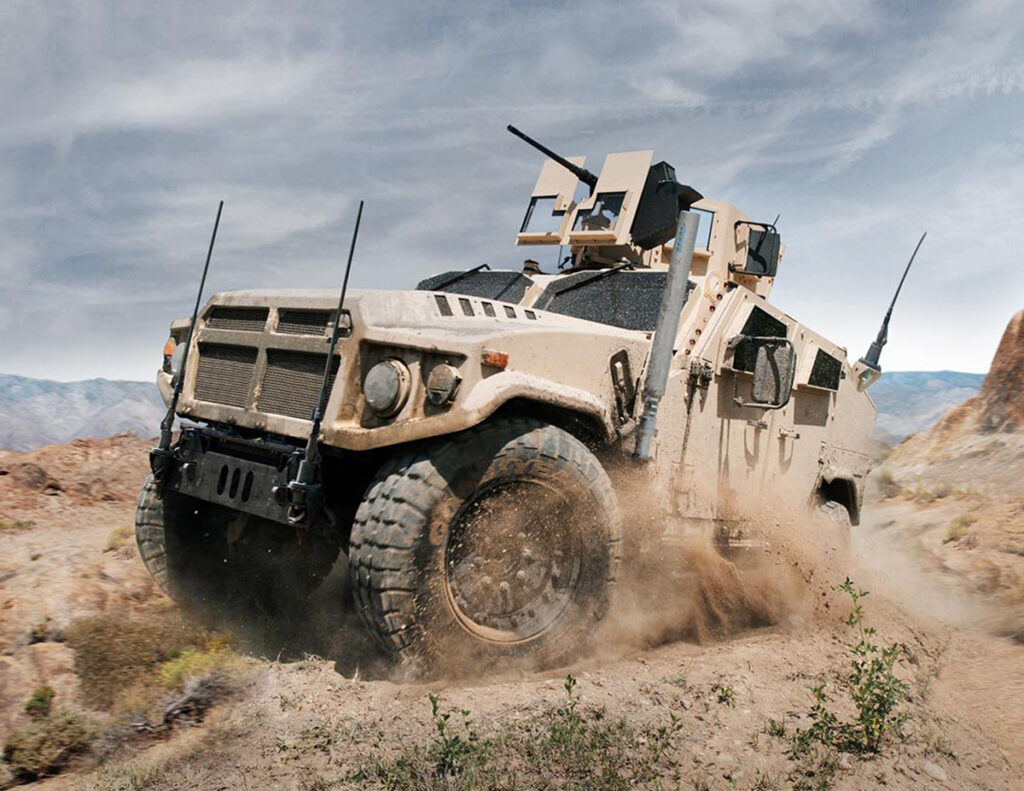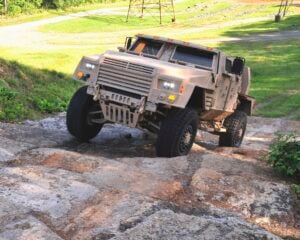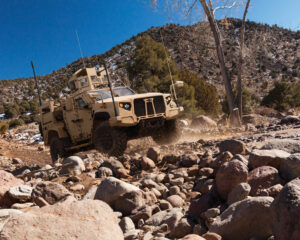The 21st Century Jeep: JLTV Race Hits Final Stretch
Posted on

AM General’s JLTV offering.
WASHINGTON: “Go drive it, Sydney,” Heidi Shyu called out across a room. “I want you to go drive it. It’s awesome.”
“It” is the JLTV, the Army and Marine Corps’ future Joint Light Tactical Vehicle, a $30 billion program for 55,000 vehicles. As the Army’s top acquisition official, Shyu will choose the winning contractor — – AM General, Lockheed Martin, or Oshkosh — “probably late this summer,” she had just told a forum at the Atlantic Council. A hands-on engineer, Shyu herself has ridden in all three models, though she didn’t have time to get trained and certified to drive them herself.

Heidi Shyu
When I made the mistake of calling JLTV just a refinement of existing technology, Shyu’s eyebrows shot up. Am I not doing the program justice, I asked her? No, you’re not, she told me. But clearly the question nagged at her, because as I was about to leave, she dashed past me grinning and made the “awesome” remark.
But what’s so awesome about JLTV? When you look at the three competitors’ vehicles, they all look pretty much like trucks. In fact, they look like smaller variations on the blocky theme of roadside-bomb-resistant wheeled vehicles — uparmored Humvees, Mine-Resistant Ambush Protected (MRAP) vehicles, M-ATVs — that became as iconic of the conflicts in Afghanistan and Iraq as the Jeep was of World War II.
Appearances, however, can deceive.
The first crucial difference is what the JLTV is meant to do: combine the protection of the bulky MRAPs with the off-road agility of the original unarmored Humvee, before layers of added armor weighed it down. Mobility matters both on the attack and on defense, because the best protection against a roadside bomb is to get off the road. Mining a key chokepoint along a predictable route is easy. Mining all possible cross-country approaches is not.
The second crucial difference is JLTV’s design. Squaring the circle of protection and mobility is impossible with traditional techniques. Even the lightest MRAP variant, the MRAP All-Terrain Vehicle (M-ATV) specifically designed for the rough ground of Afghanistan, weighs almost twice the 14,000 pounds (sans cargo) that the military wants for JLTV. That weight, in turn, brings down its cross-country speed.
“M-ATV, while it provides tremendous protected mobility, in some ways it does that through mass [of armor],” said John Bryant, senior VP for defense programs at Oshkosh, which builds the M-ATV. “In our [JLTV design] we achieve those same levels of protection and mobility through…systems engineering.”
“We don’t rely on just one item” — such as armor — to protect the people inside, said Lockheed Martin’s VP for ground vehicles, Scott Greene. “We’ve taken a system engineering approach where a number of capabilities of the vehicle are integrated together” to produce a protective effect greater than the sum of their parts.
What does that mean, in layman’s terms? The traditional approach to protection is primarily outside-in: You start with a basic vehicle, like an unarmored Humvee, and layer armor onto it. (Sometimes there are additional wrinkles like v-shaped underbodies to deflect a blast).

Lockheed Martin’s prototype JLTV
For JLTV, however, all three competitors have approached protection inside-out: They start with the vulnerable human beings riding the vehicle and build up layer after layer around them. Seats move up and down to cushion the blast. Floors “float” so they don’t transmit bone-shattering shocks to the passengers’ legs. The whole structure of the vehicle crumples and comes apart in ways carefully calculated to transmit the killing energy away from the humans.
“The protection system is designed around that occupant….allowing the structure to deflect the energy, to absorb it, to dissipate it,” said Chris Vanslager. “You don’t want the engine to come flying through the compartment” if the vehicle takes a blast from the front, he said — but if the engine blows right off the vehicle, it carries a lot of kinetic energy away from the crew compartment.
Vanslager is a vice-president at AM General, which designed and still builds the Humvee. “The survivability guys who were designing…the Humvee were not thinking about all that,” he told me. The High Mobility Multi-purpose Wheeled Vehicle (HMMWV) was originally builtd to support the M1 Abrams heavy tank and the M2 Bradley infantry fighting vehicle, two well-armed and -armored war machines meant to take the brunt of a Soviet tank assault. Like its Jeep ancestors, the Humvee was supposed to operate in the relatively safe zone “behind the lines,” said Vansleger. “Now there is no ‘behind the lines.'”
That is why the military wants JLTV. It won’t replace the Humvee altogether — the Pentagon doesn’t have the money — and it won’t be a frontline combat vehicle like a tank, but it will take on the Humvee’s traditional missions of scouting and transport in environments where there is a greater threat of homemade mines, guerrilla ambushes, artillery bombardment, and (maybe) exploding mini-drones.
Given the number of dangerous places around the planet, that requires a lot of JLTVs. The contract at stake in this year’s competition is for the first 17,000 vehicles, but the Army plans to buy 49,000 and the Marines another 5,500.

Gen. Ray Odierno
Can the cash-strapped Pentagon stick to those figures? “Yes,” outgoing Army Chief of Staff Gen. Ray Odierno said when pressed on the point at a recent press breakfast. “We have funded and we are planning on buying 49,000 and we have not walked away from that.”
Those numbers mean the challenge for the contractors isn’t just designing JLTV. It’s building it en masse at the price that the military says it can afford: $250,000 per vehicle, not counting R&D. So while there are definite technical differences in the three designs — AM General is the only one to have an integrated communications suite; Oshkosh claims a revolutionary suspension; Lockheed boasts a unique blast-deflecting hull they won’t discuss in any detail — the most crucial distinguishing factor between the competitors may be manufacturing prowess. Each competitor has distinctly different selling points about its ability to build JLTV cheaply.
AM General and Oshkosh can both point to “hot” production lines, albeit of different flavors. AM General built the 22 JLTV prototypes required for the competition in the same facility where it continues to churn out Humvees. Oshkosh built its 22 on the same line it builds M-ATVs and a host of other vehicles, from Army trucks to civilian snowplows. AM General has a heritage going back to the original Jeep and has built a staggering 281,000 Humvees for both US and foreign markets. Oshkosh has built only about 10,0000 M-ATVs, but it’s built over 70,000 military vehicles of various types — more in a month at the peak of the war than the planned annual production for the first couple years of JLTV. Both companies also have well-established global supply and maintenance networks to support both US and foreign customers.

Oshkosh’s offering for JLTV
Lockheed Martin is the outlier here. An aerospace giant best known for the high-tech but oft-troubled F-35, it bought partner BAE Systems’ entire wheeled vehicle production line and physically moved it from Sealy, Texas to Camden, Arkansas. Lockheed’s selling point isn’t continuity; it’s innovation. So what if they just started building vehicles at Camden this past fall? Their computer models have simulated 15 centuries of fabrication.
“We were able to simulate 1,500 years of production over 5.4 million vehicles,” said Randy O’Neal, VP for production at Lockheed’s Missiles & Fire Control division, which runs the Camden plant. First Lockheed’s engineering and manufacturing teams came together to simulate the complete construction of an individual JLTV — three times — to understand bolt by bolt the exact parts and processes involved. Then they took decades of real-world performance data from the Camden plant, where Lockheed has built missiles and munitions since 1981, and built a model of how the factory operated. Lastly, they ran that simulation for 5.4 million JLTVs produced under a wide range of conditions, from everything going right in the supply chain and on the factory floor to everything going wrong.
So Heidi Shyu, as the Army’s top acquisition official, faces a clear choice: a high-risk, high-return bet that Lockheed Martin’s high technology works as the simulations says it will — which didn’t really happen on the much more complex F-35 — or a safer play for either Oshkosh or AM General. Between now and 1 October, we’re going to find out which way they jump on JLTV. Then the hard part begins: actually building it to budget.
“When we look at vehicles… this is one we absolutely need,” Gen. Odierno said. “As we move forward, it’ll be a central piece of the Army.”
Subscribe to our newsletter
Promotions, new products and sales. Directly to your inbox.
